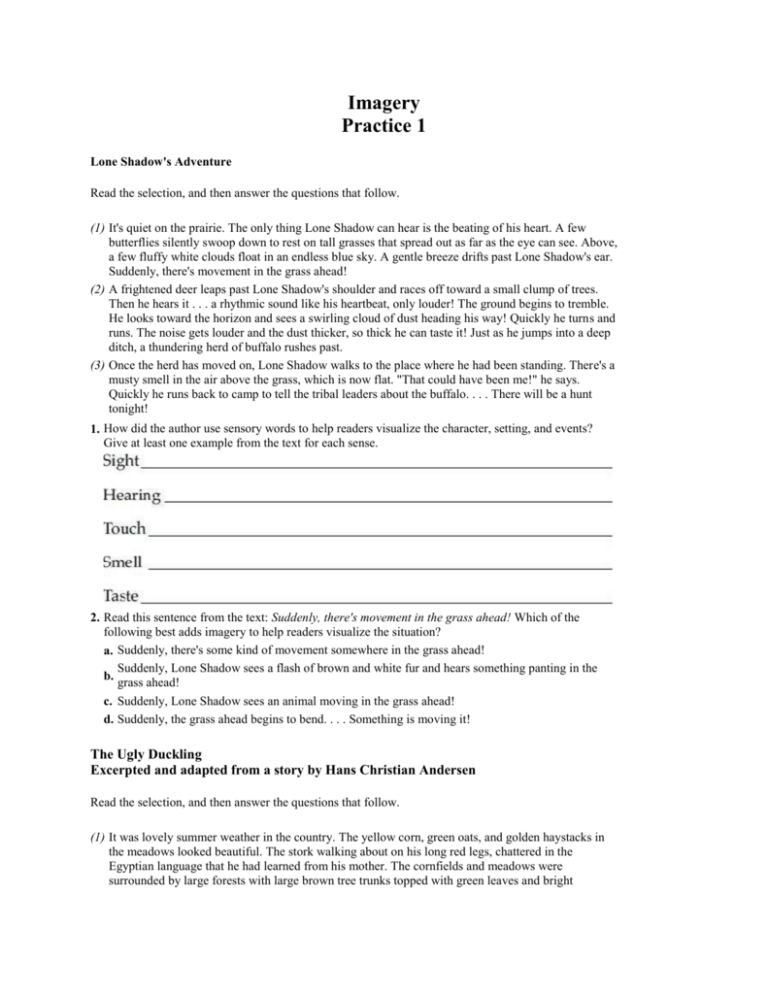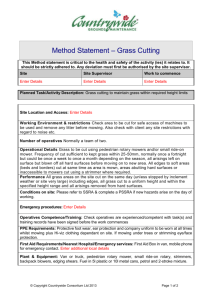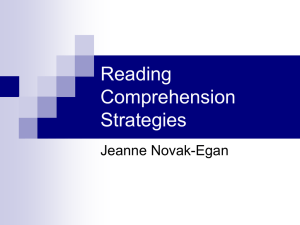Imagery Practice 1
advertisement

Imagery Practice 1 Lone Shadow's Adventure Read the selection, and then answer the questions that follow. (1) It's quiet on the prairie. The only thing Lone Shadow can hear is the beating of his heart. A few butterflies silently swoop down to rest on tall grasses that spread out as far as the eye can see. Above, a few fluffy white clouds float in an endless blue sky. A gentle breeze drifts past Lone Shadow's ear. Suddenly, there's movement in the grass ahead! (2) A frightened deer leaps past Lone Shadow's shoulder and races off toward a small clump of trees. Then he hears it . . . a rhythmic sound like his heartbeat, only louder! The ground begins to tremble. He looks toward the horizon and sees a swirling cloud of dust heading his way! Quickly he turns and runs. The noise gets louder and the dust thicker, so thick he can taste it! Just as he jumps into a deep ditch, a thundering herd of buffalo rushes past. (3) Once the herd has moved on, Lone Shadow walks to the place where he had been standing. There's a musty smell in the air above the grass, which is now flat. "That could have been me!" he says. Quickly he runs back to camp to tell the tribal leaders about the buffalo. . . . There will be a hunt tonight! 1. How did the author use sensory words to help readers visualize the character, setting, and events? Give at least one example from the text for each sense. 2. Read this sentence from the text: Suddenly, there's movement in the grass ahead! Which of the following best adds imagery to help readers visualize the situation? a. Suddenly, there's some kind of movement somewhere in the grass ahead! Suddenly, Lone Shadow sees a flash of brown and white fur and hears something panting in the b. grass ahead! c. Suddenly, Lone Shadow sees an animal moving in the grass ahead! d. Suddenly, the grass ahead begins to bend. . . . Something is moving it! The Ugly Duckling Excerpted and adapted from a story by Hans Christian Andersen Read the selection, and then answer the questions that follow. (1) It was lovely summer weather in the country. The yellow corn, green oats, and golden haystacks in the meadows looked beautiful. The stork walking about on his long red legs, chattered in the Egyptian language that he had learned from his mother. The cornfields and meadows were surrounded by large forests with large brown tree trunks topped with green leaves and bright (2) (3) (4) (5) blossoms. In the midst of the forests were deep pools of clear, sapphire water. Beside the forests was a river, and close by stood a pleasant old farmhouse. From the house, one could see down to the water, where great thistles grew so high that under the tallest dark green leaves, a small child could stand upright! This wild, secluded spot formed a snug retreat in which a duck sat on a nest, waiting for her young brood to hatch. The duck was beginning to tire of her task, for the little ones were a long time coming out of their shells, and she seldom had any visitors. The other ducks much preferred swimming in the river than climbing the slippery banks to sit under a thistle leaf and talk with her. She shifted on the itchy twigs of her nest. Finally, she heard one shell crack, and then another and another, and from each came a fuzzy creature that lifted its head and cried, "Peep, peep!" "Quack, quack," said the mother as she stroked each soft, yellow duckling. They looked about them on every side at the large green leaves. Their mother allowed them to look as much as they liked, because green is good for the eyes. "How large the world is," said the young ducks, when they found how much more room they had now than while inside their white eggshells. "Do you imagine this is the whole world?" laughed their mother. "Wait till you have seen the garden; it stretches far beyond that field, but I have never ventured such a distance. Are you all out?" she continued, rising. "No, the largest egg lies there still! I wonder how long this is to last; I am quite tired of it!" Then she fluffed her feathers and seated herself again on the nest. 3. How does the author help readers "visualize" the stork? a. by telling about its nest and what its eating b. by telling about the color of its feathers and eyes c. by telling the size and color of its legs and how it's talking d. by telling what it does when it sees the duck 4. How does the author help readers visualize the meadow? a. by explaining how each of the buildings is used b. by describing the colors of plants and other things c. by telling how old the trees are d. by describing all the fish 5. Read this sentence from the text: It was lovely summer weather in the country. Which of the following best adds imagery to help readers visualize the setting? a. It was lovely warm summer weather in the country. b. It was a warm, summer day and the sun's rays bathed the countryside in a soft, golden light. c. It was nice summer weather with plenty of sunshine all over the country. d. It was a hot summer day, so hot that the city streets were steaming. 6. Read this sentence from the text: Beside the forests was a river, and close by stood a pleasant old farmhouse. Which of the following best adds imagery to help readers visualize the place? a. Beside the trees runs a river, and not far away is an old farmhouse. b. Beside the forests of trees was a long river, and close by the river there was a nice but old farmhouse. A bubbling river raced beside the forests, spilling its liquid over smooth white rocks below a steep hill on c. which sat an old abandoned, red farmhouse. d. Along the sides of the forests was a rocky river, and further down the path there was an old white farmhouse. 7. What sounds does the author use to appeal to readers' sense of hearing? a. cracking of the eggs b. peeping of the ducklings c. quacking of the mother duck d. all of the above 8. How did the author appeal to the readers' sense of touch? Give examples from the text to support your ideas.









